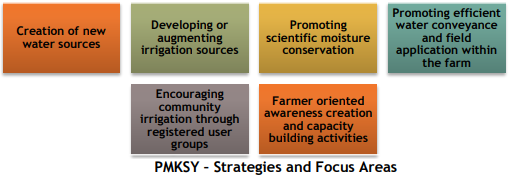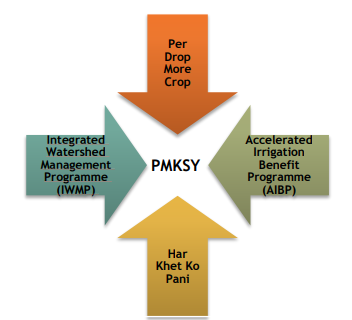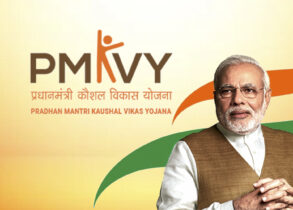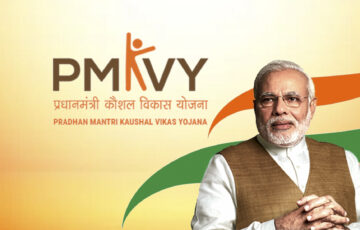Pradhan Mantri Krishi Sinchai Yojana- 1.0
Relevance
- GS Paper 2 Important aspects of governance, transparency and accountability, e-governance, applications, models, successes, limitations, and potential;
- Government policies and interventions for development in various sectors and issues arising out of their design and implementation.
- Tags: #pmksy #krishi #sinchai #scheme #currentaffairs #upsc
What is Pradhan Mantri Krishi Sinchai Yojana and Its objectives?
It aims to expand the area under assured irrigation, enhance on-farm water use efficiency, promote precision irrigation and water-saving technologies, boost aquifer recharge, and encourage sustainable water conservation practices.
PMKSY explores the feasibility of reusing treated municipal wastewater for peri-urban agriculture and aims to attract greater private investment in precision irrigation systems.
- It is a Centrally Sponsored Schemes.
- It serves as the central portal for all PMKSY components and facilitates data collection and reporting for the Per Drop More Crop (PDMC) Scheme, implemented under the Rashtriya Krishi Vikas Yojana (RKVY).
- PMKSY amalgamates existing schemes such as the
- Accelerated Irrigation Benefit Programme (AIBP),
- Integrated Watershed Management Programme (IWMP), and
- On Farm Water Management (OFWM).
- Its implementation involves multiple ministries, with the
- The Ministry of Rural Development focuses on rainwater conservation and the construction of various water-harvesting structures.
- The Ministry of Jal Shakti takes responsibility for creating assured irrigation sources and developing irrigation infrastructure.
- The Ministry of Agriculture promotes efficient water conveyance and precision irrigation methods, alongside activities to enhance moisture conservation and agronomy.
- The program’s architecture adopts a decentralized approach, allowing states to develop their irrigation plans based on District Irrigation Plans (DIP) and State Irrigation Plans (SIP).
Components
| Accelerated Irrigation Benefit Programme (AIBP) | ● Under Ministry of Jal Shakti (MoJS)
● Focuses on expediting the completion of ongoing Major and Medium Irrigation projects, including National Projects. |
| Har Khet ko Pani | ● Under Ministry of Jal Shakti (MoJS)
● Aims to create new water sources through Minor Irrigation, both surface and groundwater. ● Involves repairing, restoring, and renovating water bodies, strengthening traditional water sources, and constructing rainwater harvesting structures. ● Focuses on command area development and improving water management for better distribution, with at least 10% coverage under micro/precision irrigation. ● Supports the diversion of water from areas with surplus to those facing scarcity, including lift irrigation from lower-elevation water bodies/rivers. ● Emphasizes the creation and rejuvenation of traditional water storage systems in various regions. |
| Integrated Watershed Management Programme (IWMP) | ● Under Department of Land Resources, Ministry of Rural Development (MoRD)
● Involves the construction of water harvesting structures like check dams, nala bunds, farm ponds, and tanks. ● Focuses on capacity building, ridge area treatment, drainage line treatment, soil and moisture conservation, afforestation, and livelihood activities for asset-less individuals. ● Promotes effective rainfall management techniques, including field bunding, contour bunding, trenching, and mulching. |
| Per Drop More Crop | ● Under Department of Agriculture & Cooperation, Ministry of Agriculture (MoA)
● Includes program management, State/District Irrigation Plan preparation, approval of annual action plans, and monitoring. ● Promotes efficient water conveyance and precision water application devices such as drips, sprinklers, and rain-guns. ● Provides support for civil construction activities under MGNREGA, including lining inlet, outlet, silt traps, and distribution systems. ● Encourages the construction of micro-irrigation structures to supplement source creation activities, secondary storage structures, and water lifting devices. ● Focuses on extension activities for the promotion of moisture conservation, agronomic measures, and community irrigation. ● Conducts awareness campaigns on water-saving technologies and efficient practices. ● Promotes advanced distribution systems such as the pipe and box outlet system with controlled outlets to enhance water use efficiency. |
Beneficiary
The Pradhan Mantri Krishi Sinchai Yojana (PMKSY) has a wide-reaching impact, benefiting a broad spectrum of stakeholders, primarily focusing on farmers and agricultural communities across India. The key beneficiaries include:
- Farmers: The primary beneficiaries are farmers of all classes and divisions who gain access to improved irrigation facilities, helping them expand their cultivable areas and enhance crop yields. This is particularly advantageous for small and marginal farmers who often face water scarcity.
- Landowners: Landowners who possess agricultural land can leverage the scheme to enhance the value and productivity of their holdings through assured irrigation.
- Cooperative Societies: Members of self-help organizations, trust cooperative societies, and producer farmer groups benefit from the Yojana through registration. These entities can access resources and support for implementing water-saving technologies and improving irrigation practices.
- Leasing Arrangement Farmers: Those farmers who cultivate land under leasing arrangements are eligible for the PMKSY, enabling them to upgrade irrigation systems and boost agricultural productivity.
- While the focus is primarily on Indian citizens, the entire nation benefits indirectly from PMKSY as it leads to increased agricultural productivity, which has a cascading effect on food security and the overall economy.
Implementation of the Scheme
- National Steering Committee (NSC):
- Chaired by the Prime Minister, the NSC is an Inter-Ministerial committee.
- Comprising Union Ministers from relevant Ministries, it supervises and monitors the program at the national level, ensuring high-level oversight and coordination.
- National Executive Committee (NEC):
- Led by the Vice Chairman of NITI Aayog, the NEC oversees various aspects of program implementation.
- This includes resource allocation, inter-ministerial coordination, monitoring, performance assessment, and addressing administrative matters. It plays a pivotal role in shaping the Yojana’s direction and effectiveness.
- State Level Sanctioning Committee (SLSC):
- At the state level, the SLSC is chaired by the Chief Secretary of the respective States.
- Empowered with the authority to sanction projects, the SLSC also holds responsibility for monitoring the scheme’s progress. This ensures that decisions and actions align with local needs and conditions.
- District Level Implementation Committee:
- Operating at the district level, this committee focuses on ensuring efficient coordination at the field level.
- Its primary role is to bridge the gap between policy and implementation, facilitating the practical and localized execution of the PMKSY, ultimately benefiting farmers and communities on the ground.
These committees, from the national to the district level, create a structured framework for PMKSY’s effective implementation, oversight, and alignment with local requirements, ensuring that the program’s objectives are met with precision and efficiency.
Features
- Convergence of Investments: PMKSY seeks to promote the convergence of investments in irrigation at the grassroots level to avoid duplication and optimize resource utilization.
- Expansion of Cultivable Area: The scheme aims to expand the area under assured irrigation, reducing dependence on rainfall and increasing agricultural productivity.
- Enhanced Water Use Efficiency: PMKSY promotes on-farm water use efficiency, helping farmers make the most of the available water resources and reducing water wastage.
- Precision Irrigation: The program encourages the adoption of precision irrigation techniques and water-saving technologies to maximize agricultural output while minimizing water usage (“More crop per drop”).
- Aquifer Recharge: PMKSY places a strong emphasis on recharging aquifers, ensuring the sustainable use of groundwater resources.
- Reuse of Treated Wastewater: The scheme explores the feasibility of reusing treated municipal wastewater for peri-urban agriculture, fostering environmental sustainability.
- Private Investment Promotion: PMKSY aims to attract greater private investment in precision irrigation systems, promoting innovation and technology adoption.
- Decentralized Planning: The program adopts a decentralized state-level planning structure, allowing states to create irrigation development plans based on local needs.
- Multi-Ministerial Approach: PMKSY integrates multiple ministries, including Agriculture, Water Resources, and Rural Development, to address various aspects of irrigation and water resource management.
- Robust Oversight: The scheme’s implementation is overseen by committees at both the national and state levels, ensuring effective monitoring, coordination, and resource allocation.
Mains question
In what ways do the key features of the Pradhan Mantri Krishi Sinchai Yojana contribute to sustainable agricultural development and water resource management in India? Analyze with examples.







